AMD's Phenom II X4 965 Black Edition
by Anand Lal Shimpi on August 13, 2009 12:00 AM EST- Posted in
- CPUs
SYSMark 2007 Performance
Our journey starts with SYSMark 2007, the only all-encompassing performance suite in our review today. The idea here is simple: one benchmark to indicate the overall performance of your machine.
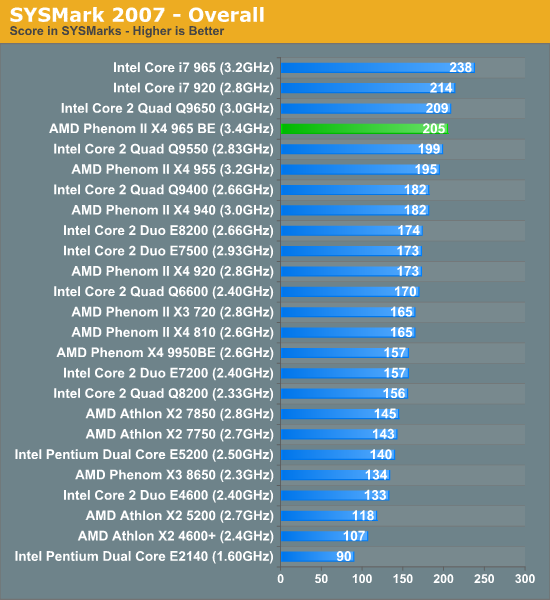
The Phenom II X4 965 does very well, inching ahead of the Q9550 and basically performing the same as the Core i7 920. Not bad at all.
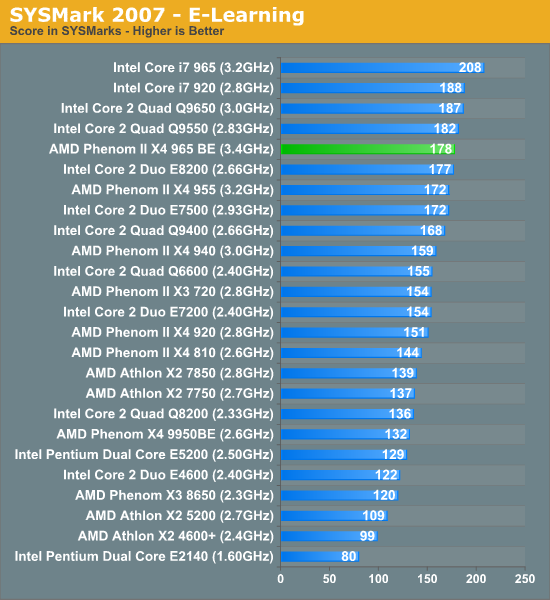
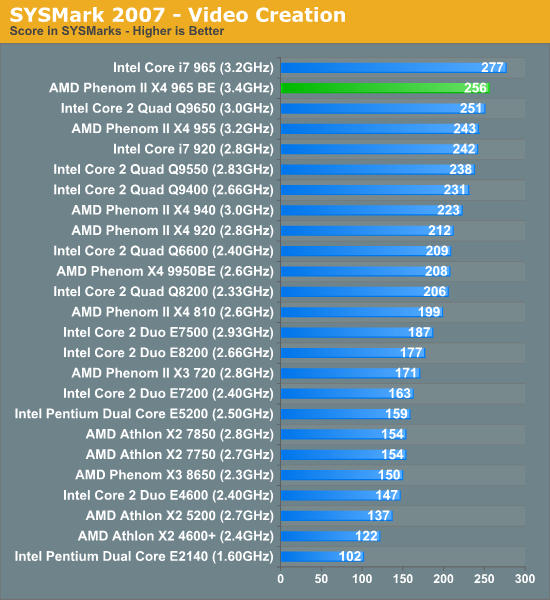
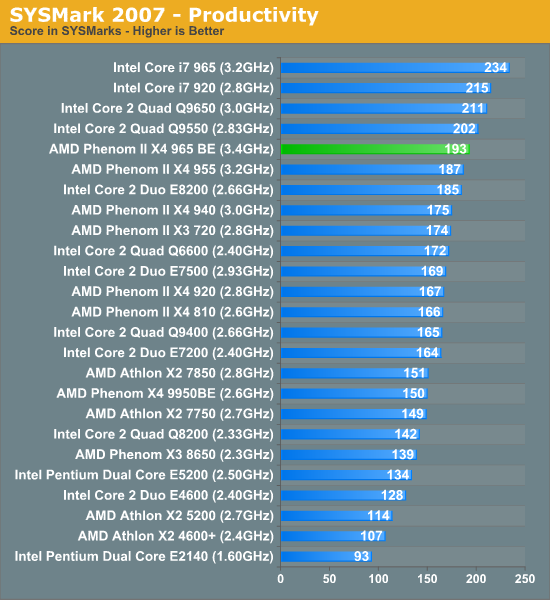
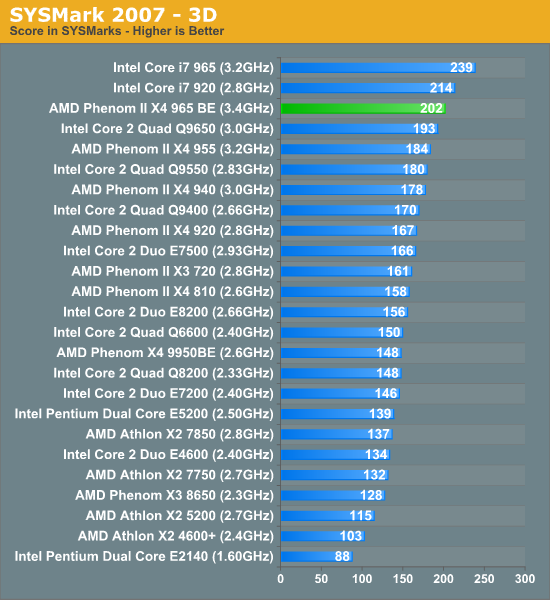










54 Comments
View All Comments
andrenb91 - Tuesday, August 18, 2009 - link
amd's only hope to beat the i7s is the istambul core, if it brings istambul to the desktop market, I guess this future cpu can beat some high-end i7 processors, and after some revisions on the deneb core, amd will place it to ''fight'' the i5s leaving the athlon x4 playing against the i3s, but most denebs must be at 95W to be efficient against i5. of course this strategy depends if amd is economically capaple of putting a 300mm squared die in the desktop market...deneb is already too large to compete against the i7!ash9 - Thursday, August 13, 2009 - link
"Now once you start throwing in background tasks and look at future titles being more threaded then the picture becomes a little more muddy"I dont understand where the writer is going with these conclusions. As CPUGPU or OpenCL begins to take hold, the old comparative model of simply looking at raw speed becomes obsolete, now, overall power can be reduced while concurrent events run parallel in multicores and GPU, thats is where AMD is heading. These comparisons with Vista may not be as eye opening as compared on Windows 7 or DirectX 11, this is where AMD planed to rock and roll from the start.
GourdFreeMan - Thursday, August 13, 2009 - link
You are looking too far forward into the future for a product that is going to be used by consumers for the next 2-3 years. Yes, there is a general move among all vendors (AMD, nVIDIA and Intel) towards moving largely parallel computation onto GPUs, however you must keep in mind CUDA has been around for 2.5 years and Brook even longer than that, yet GPGPU has only found commercial consumer application in media encoding and Adobe Photoshop. To expect a sudden shift when DX11 is released as a commercial product as part of Windows 7 later this year is wishful thinking at best. Programmers require time to learn new skills, adopt new methodologies and experiment to determine what works more efficiently and what doesn't. That time will be measured in years, not months.If we restrict ourselves to the domain of PC gaming, then Anand's comments are accurate, if a little dated. Programmers have finally adopted multithreaded (CPU) development with a vengeance. Most new games are multithreaded, regardless of whether they are a console port or the rare instance of the dying breed of PC exclusives. The first dual core consumer CPUs were released more than 4 years ago. That should give you some idea of how agile PC games development actually is. We still don't have many titles with 64-bit executables despite how long ago 64-bit CPUs and operating systems were released.
Finally, there remain open questions of where tasks belong and what to do with unused processing capability on the CPU and GPU. You can put physics on the GPU, but what about AI? Game logic? Branchy scripts written by content creators as opposed to programmers? You can use your unused GPU cycles to do more graphically or at a higher frame rate, but can't you also find more tasks for your CPU that will contribute to gameplay? World simulation and more complicated AI immediately spring to mind.
ravaneli - Thursday, August 13, 2009 - link
Price: in retail price comparison the 9550 is a little cheaper. Talking about deals, my microcenter had about a hundred of them in stock at $169 each.Performance, even at stock 2.83 ghz the 9550 will take on the 965. You can take a look at toms hardware for another set of results. They looked quite humiliating. The 9550 will however overclock to 4ghz even with stick cooler due to really low cpu voltage.
All AMD did with this chip is change the multiplier for you. And charge you for that. Thank's, but I can do this myself in 2 mins.
Not to say that 9550 is all that great, but I find the superiority fight with the 965 a quite tough one at least. How did u write it off so quickly and went quickly to comparing to i7. A lot of water will pass under the bridge before we see anything from AMD that competes with i7. Keep you comments about price of platform. It's not like you pay more money for the same product. You pay more for memory BUT YOU DO HAVE FASTER MEMORY, DONT YOU?? And read around, reliable OC motherboards under 200 are not rare any more.
OblivionLord - Thursday, August 13, 2009 - link
I dont understand why you people are comparing newer intel chips such as the i5 and i7 to the 955 and 965 when the AMD chips arent even in the same league as the i7/i5. Infact the 955 and 965 has worse power efficiency than Yorksfield chips. To be blunt, Anandtech said that in a 64bit Windows environment the 965 couldn't pass 4ghz. At stock speed the 3.4ghz processor has a stock voltage of 1.4v. That's almost on par with Kentsfield quad power requirement. My 4.0ghz Q9550 oc'ed only needs 1.3625v and that's oc'ed compared to the 965's 1.4v at stock 3.4ghz which is insane. When my chip is at 3.8ghz I set the vcore to 1.3265. That's still 400mhz more than the 965 at stock which needs 1.4v.There is nothing that can tell me that Phenom 2 is anywhere comparable with anything past Yorksfield when it simply isn't.
IKeelU - Thursday, August 13, 2009 - link
Keep in mind that price is what we use to compare one processor to another. I don't think anyone is disputing that the I7 is a more technologically "advanced" microprocessor, but my wallet doesn't really care about that, and neither do OEMs I think. Ultimately, the TDP is something you should take into account when determining the overall cost of ownership. This is something that is difficult to evaluate objectively because everyone has different usage patterns, and the cost of energy varies from place to place. So we must evaluate based on a more spatially-constant cost, which is the purchase price.Nfarce - Thursday, August 13, 2009 - link
Exactly. It is not Intel's fault that AMD has been asleep at the switch for several years now and reduced to rehashes of previous architectures. I want to see AMD keep Intel on its toes, but nothing from them currently makes me want to give up staying with Intel. And the way the future road map looks from Intel, I don't see that changing any time soon.arbiter378 - Friday, November 6, 2009 - link
Your wrong, it is intel's fault. http://ec.europa.eu/competition/sectors/ICT/intel....">http://ec.europa.eu/competition/sectors/ICT/intel....Nfarce - Thursday, August 13, 2009 - link
Those chips are certainly much more popular than the E8200, which is discontinued now most likely due to low sales. Besides, I think a 3.16GHz or 3.33GHz Wolfdale is more in line with the rest of the upper spectrum chips than one running at 2.66GHz.What would really be cool is a mass overclock comparison (on air) for the top 10 chips listed here. That would more in line reflect real world users here as well. Let's go with a head to head AMD vs. Intel overclock comparison!
haplo602 - Thursday, August 13, 2009 - link
so we have a new top end AMD cpu. the benchmarks are about what I expected them to be.AMD is nearing the limit of current Phenom II technology. They should introduce something new and better soon after i5 hits the streets or they are loosing on almost all fronts to Intel.